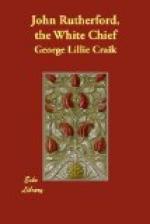[Footnote AW: These words are not in accord with the present system of spelling, there being no “sh” and no “c” in the Maori orthography. The former name is probably Hau, and the latter Peka. The letter “E” placed in front of them is used by the Maoris to denote the vocative, and Rutherford has evidently taken it as part of the word. Sometimes the “E”—which is pronounced as “a” in “pay”—is placed both before and after the name of the person addressed, as “E Peka, e!”]
[Footnote AX: The latter word is correct.]
[Footnote AY: Arikis.]
[Footnote AZ: Tuki.]
[Footnote BA: This is the man referred to in a previous chapter, who signed a deed of sale to Marsden by the pattern of his tattoo.]
[Footnote BB: Maning, in “Old New Zealand,” gives a delightful account of the manner in which the law of muru, or plunder, ruled with an iron hand in the ancient Maoriland.]
CHAPTER VIII.
With regard to many of the other habits of the New Zealanders, Rutherford in general corroborates the testimony of other travellers.
He mentions particularly their extreme inattention to personal cleanliness, a circumstance which very much surprised Nicholas, as it seemed to present an unaccountable contrast to the neatness and order which were usually to be found both in their plantations and huts.
All the natives, Rutherford states, are overrun with vermin, which lodge not only in their heads, but in their mats. “Their way of destroying them in their mats,” he adds, “is by making a fire, on which, having thrown a quantity of green bushes, they spread the mat over the whole, when the steam from the leaves compels the vermin to retreat to the surface: these the women are very active in catching on such occasions with both hands, and devouring greedily. Sometimes two or three will be catching them at the same mat.”
The New Zealanders cure their fish, Rutherford tells us, by dipping them a great many times in salt water, and then drying them in the sun. The large mussels they first bake in the usual manner, and then, taking them out of the shell, string them together, and hang them up over the fire to dry in the smoke. Thus prepared, they eat like old cheese, and will keep for years. The coomeras, or sweet potatoes, are also cured in the same manner, which makes them eat like gingerbread. Their potatoes the natives pack in baskets made of green flax, and in this way preserve them for the winter. There are, however, three months in the year during which they live upon little except turnips, and at this time they do with almost no drink. The baskets in which they keep their provisions, and apply to other domestic purposes, are formed with considerable ingenuity, and with some taste, in their decorations.
Notwithstanding the stormy seas by which their islands are surrounded, and the woods, swamps, and rivers, which oppose such difficulties in the way of passing from one place to another through the heart of the country, the New Zealanders are known to be in the habit of making long journeys, both along the coasts in their canoes, and through the interior on foot.




